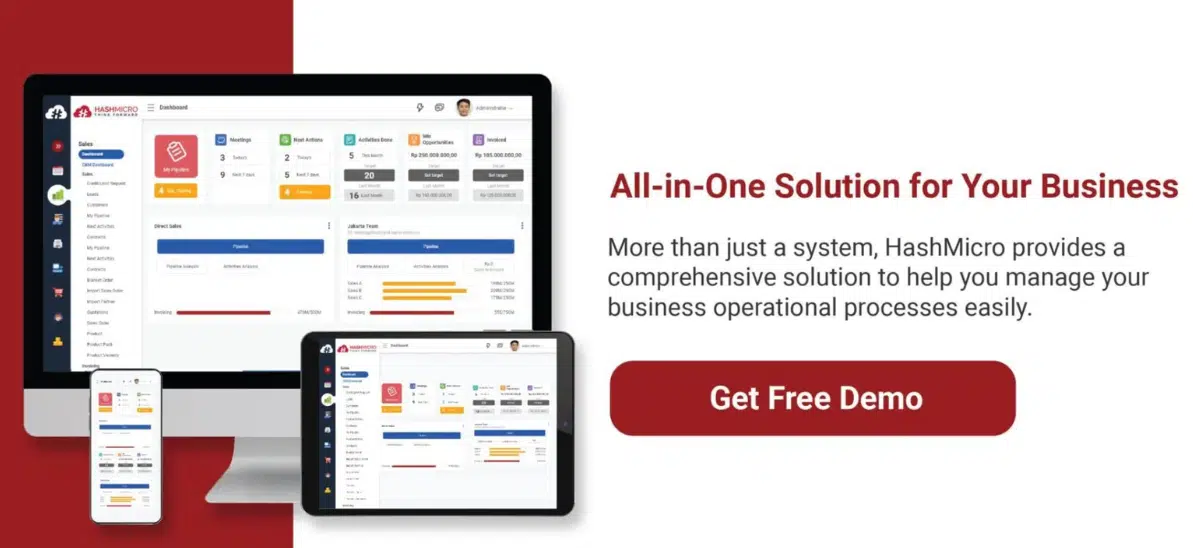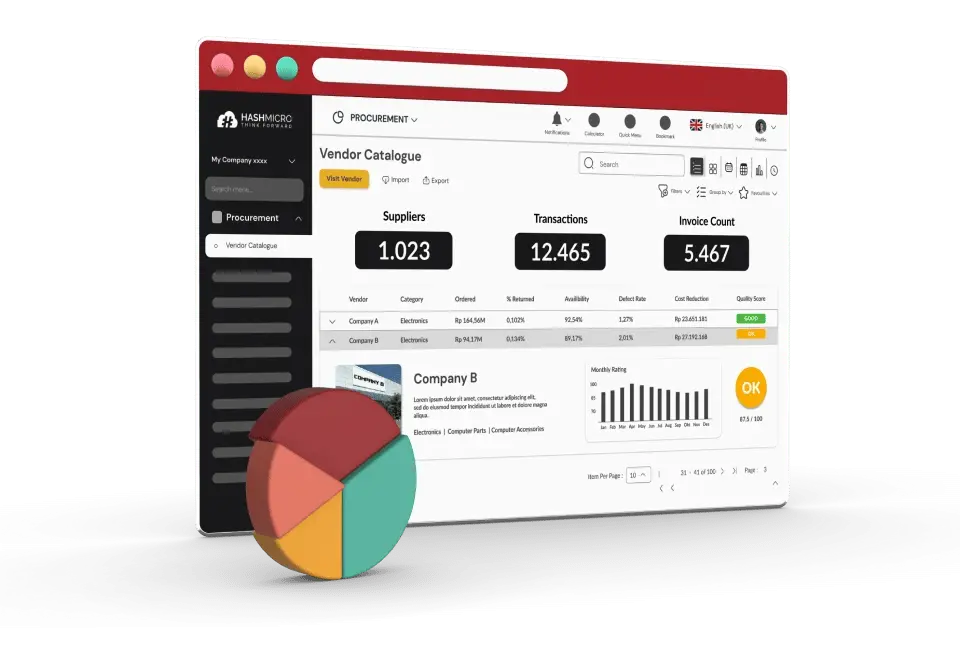Managing procurement processes efficiently is no longer a luxury—it’s a necessity. One key element in procurement is the Purchase Order (PO) system, which is crucial in ensuring transparency, accuracy, and control over company spending.
Reflecting this growing importance, the global market for procurement software was valued at approximately USD 6.15 billion in 2023 and is projected to reach USD 9.5 billion by 2028, growing at a compound annual growth rate (CAGR) of 9.1%.
This is where modern solutions like HashMicro Procurement Software come into play. With automated purchase requests, multi-level approvals, and real-time tracking, HashMicro helps businesses reduce errors and make data-driven purchasing decisions.
This article will explore a purchase order system, why it matters, common challenges businesses face, and how an advanced tool like HashMicro Procurement can transform your operations.
Table of Content:
Table of Content

Key Takeaways
|
What Is a Purchase Order System?
A Purchase Order (PO) system is a digital tool that helps businesses create, manage, and track purchase orders efficiently. It automates the purchasing workflow from request submission to approval and order fulfillment.
A PO system centralizes procurement data and streamlines communication between departments and vendors, replacing manual paperwork or scattered spreadsheets.
It ensures that each purchase goes through the proper approval process, reduces the risk of errors or duplicate orders, and improves transparency across the organization. Many systems are also integrated with inventory, finance, and reporting tools.
In Singapore, the use of PO systems is increasingly common, especially among businesses seeking operational efficiency and compliance with financial regulations. Companies benefit from faster processing times, real-time cost tracking, and improved accuracy in their procurement activities.
How Does a Purchase Order System Work?
A purchase order (PO) system automates and streamlines the entire procurement workflow, starting from a purchase request and ending with payment approval.
It ensures that each purchase goes through the right steps—properly documented, authorized, and tracked—so companies can control spending and supplier communication.
The typical process within a PO system works as follows:
- Purchase Request Submission: A department identifies a need for goods or services and submits a request through the system.
- Approval Workflow: The request is routed to the appropriate approver(s) based on the company’s rules, such as the department head, finance, or procurement manager.
- PO Generation and Sending: Once approved, the system automatically generates a purchase order, which is sent to the selected vendor with complete order details.
- Order Fulfillment: The vendor delivers the goods or services based on the PO. The system allows for real-time delivery status updates.
- Receipt and Verification: Upon receipt, the goods are checked against the PO and invoice in a process called three-way matching, which compares the PO, delivery receipt, and invoice to confirm accuracy.
- Payment Approval and Processing: If everything matches, the invoice is approved, and payment is released, often integrated with the company’s accounting system.
Throughout this cycle, the PO system keeps detailed records of each step, creating transparency and reducing the risk of errors or fraud.
A PO system digitizes the procurement process, helping businesses save time, minimize manual errors, and improve departmental accountability.
Key Benefits of an Automated Purchase Order System
There are many strategic reasons to use purchasing software, from improving procurement accuracy and speeding up approval workflows to gaining better visibility over spending and vendor performance.
Adopting an automated purchase order (PO) system online is a strategic move for businesses aiming to streamline operations and gain tighter control over spending. Below are four key benefits that make PO automation a game changer for modern procurement teams:
1. Increased accuracy and fewer errors
Manual PO handling often leads to human errors in pricing, quantity, or vendor details. An automated system reduces these risks by standardizing the order process and eliminating repetitive data entry.
This ensures that each PO is accurate and consistent, saving time that would otherwise be spent on fixing mistakes.
2. Faster and more efficient procurement
Speed is crucial in procurement, especially when operational needs are time-sensitive. With automation, approval workflows are streamlined, orders are processed faster, and follow-ups become automatic.
3. Better cost control and budget tracking
An automated PO system offers real-time visibility into purchase requests and spending patterns. Approval rules can be set based on budgets or departments, ensuring no purchase slips through without oversight.
4. Full transparency and audit readiness
Every transaction in an automated system is logged—from who approved the PO to when it was fulfilled. This audit trail supports internal compliance and simplifies external audits. It also builds trust across teams, as everyone can easily track the status and history of each cloud-based purchase order system.
In short, an automated PO system streamlines the procurement process, supports smarter decision-making, enhances accountability, and allows businesses to scale their operations confidently.
You can also read our article on purchase requisition vs. purchase order to better understand their differences and how each plays a role in the procurement process.
Common Challenges of PO Systems
While purchase order (PO) systems offer clear advantages in streamlining procurement, they’re not without their challenges—especially if the system is outdated, poorly implemented, or lacks integration with other business tools. Understanding these common obstacles can help businesses anticipate issues and choose the solution that fits their operational needs.
1. Lack of Integration with other systems
Many PO systems operate in silos, making it difficult to sync with accounting, inventory, or ERP platforms. Without proper integration, data has to be transferred manually between systems, increasing the risk of errors and delays. This also limits real-time visibility across departments.
2. Poor user adoption
Even the most advanced system will fail if users find it confusing or cumbersome. A complicated interface, unclear workflows, or lack of training can lead employees to bypass the system altogether, undermining the purpose of automation and creating inconsistencies in procurement data.
3. Limited customization and flexibility
Some PO systems are too rigid to adapt to different approval hierarchies, supplier requirements, or business rules. This can slow down processes or force teams to work around the system rather than with it. Over time, this creates inefficiencies and user frustration.
Types of Purchase Order Systems
There are several types of PO systems, each with its own set of advantages and limitations. Below, we explore three common types of PO systems to help you understand which one might best fit your organization.
1. Manual purchase order system
A manual PO system is the traditional approach where employees manually create, process, and approve POs using paper forms or spreadsheets. This system involves a lot of physical paperwork and relies heavily on human intervention, which can lead to errors, delays, and inefficiencies.
While it may seem straightforward for small businesses or those with minimal procurement needs, a manual system lacks scalability and is prone to duplicate orders, incorrect pricing, and lost paperwork.
2. Online/automated purchase order system
An online/automated purchase order system leverages technology to automate the entire procurement process. These systems allow businesses to create, track, and approve POs digitally, reducing manual tasks and improving efficiency.
Once the approval workflow is completed, orders are generated automatically and sent to vendors through digital platforms.
3. ERP integrated purchase order system
An ERP-integrated purchase order system is a part of a larger Enterprise Resource Planning (ERP) solution, where procurement is seamlessly integrated with finance, inventory management, and other business functions.
This system offers a holistic approach, allowing real-time updates across various departments. For example, inventory levels are automatically updated as new orders are placed, and invoices are matched with POs during payment.
How to Choose the Best Purchase Order System
With many solutions available in the market, assessing the system’s features and how well it aligns with your business needs is important. Here are several key considerations to help guide your selection process:
1. Assess your business needs
Are you dealing with high-volume orders, multiple approval levels, or recurring purchases? Understanding your operational complexity will help determine whether you need a basic system, a fully automated platform, or an ERP-integrated solution.
2. Look for customizable approval flows
A good PO system should allow you to set custom approval hierarchies based on department, order value, or project. This ensures accountability and compliance without creating bottlenecks in the purchasing process.
3. Prioritize integration capabilities
Ensure the system integrates seamlessly with your accounting, inventory, and ERP tools. Integration eliminates duplicate data entry, improves accuracy, and allows for real-time visibility across departments—key to making informed procurement decisions.
4. Consider ease of use and training
The system should be intuitive enough for users across departments, not just the procurement team. A complicated interface can hinder adoption, so choose a platform with user-friendly navigation and training resources that make onboarding easier.
5. Evaluate reporting and analytics
Robust reporting tools are essential for tracking purchase trends, supplier performance, and budget adherence. Look for systems with customizable dashboards and real-time data to support better forecasting and decision-making.
Streamline Your Purchase Order Process with HashMicro Procurement
Managing purchase orders manually is often slow, error-prone, and unsustainable as a business scales. That’s why many companies now turn to automation—like HashMicro Procurement, a comprehensive solution built to streamline and control the entire purchasing process.
With HashMicro Procurement, businesses can automate the creation, approval, and tracking of purchase orders in real time. The system allows users to set up customized approval flows based on department or order value, ensuring that every purchase is authorized and compliant with internal policies.
HashMicro integrates seamlessly with your accounting, inventory, and ERP systems, automating data flow and eliminating the need for manual input. Schedule a free demo with our team to explore how this integration works in real time.
Key features of HashMicro Procurement System
- Automated Purchase Order Generation: Once requisitions are approved, purchase orders are automatically generated, reducing manual work and ensuring timely, error-free order processing.
- E-Procurement for Online Tenders and RFQ / ITQ: Digitize the tender and quotation process with an integrated platform for managing RFQ (Request for Quotation) and ITQ (Invitation to Quote), improving transparency and speeding up vendor selection.
- OCR for RFQ: Automated Optical Character Recognition (OCR) helps extract data from incoming vendor documents, reducing manual entry and minimizing errors in the quotation comparison process.
- KPI Target per Purchaser: Set and monitor performance targets for each purchaser to ensure accountability, efficiency, and alignment with procurement goals.
- Cost Savings Tracking and Reporting: Tracked realized cost savings from procurement activities and generated detailed reports to measure impact and optimize budgeting strategies.
- Vendor Promotion Program: Easily manage vendor promotions, discounts, and special offers within the system to maximize value from your supplier relationships.
Conclusions
A purchase order system is a comprehensive solution that brings structure, visibility, and control to the procurement process. Adopting the right PO system eliminates inefficiencies, reduces errors, and ensures smarter spending.
As demonstrated throughout this guide, choosing a system that fits your business needs—especially one that offers automation, integration, and scalability—can make a significant difference.
That’s where HashMicro Procurement stands out. Designed to simplify and streamline purchasing operations, it offers advanced features such as customizable approval flows, real-time tracking, and seamless ERP integration to help businesses operate with greater agility and precision.
Schedule a free demo with HashMicro today and discover how the right purchase order system can drive efficiency and growth in your business.
FAQ About Purchase Order System
-
What’s the difference between PR and PO?
The key distinction between a purchase requisition and a purchase order lies in their purpose— a requisition is used to request internal approval to make a purchase, while a purchase order is issued to formally buy the approved goods or services.
-
Can a purchase order have multiple invoices?
Yes, purchase orders can be issued for goods and services to accommodate multiple invoices over a set period. Payments are made against the invoices once the goods are received, up to the approved amount specified in the PO.
-
What is purchase order workflow?
The PO approval workflow includes various documents at each stage, from requisition to payment. A purchase order outlines the items to be bought, quantity, agreed price, shipping details, and any other relevant purchase information.




































